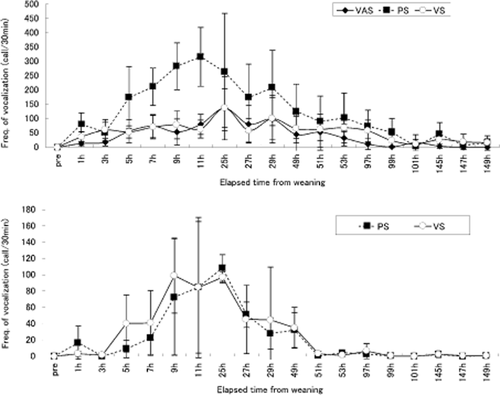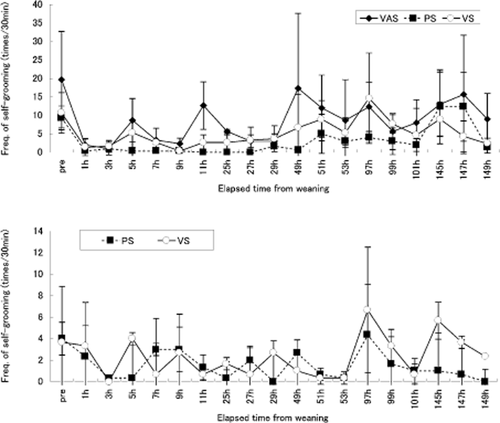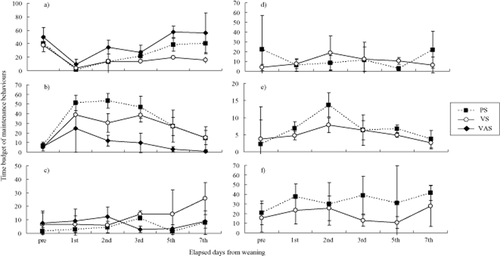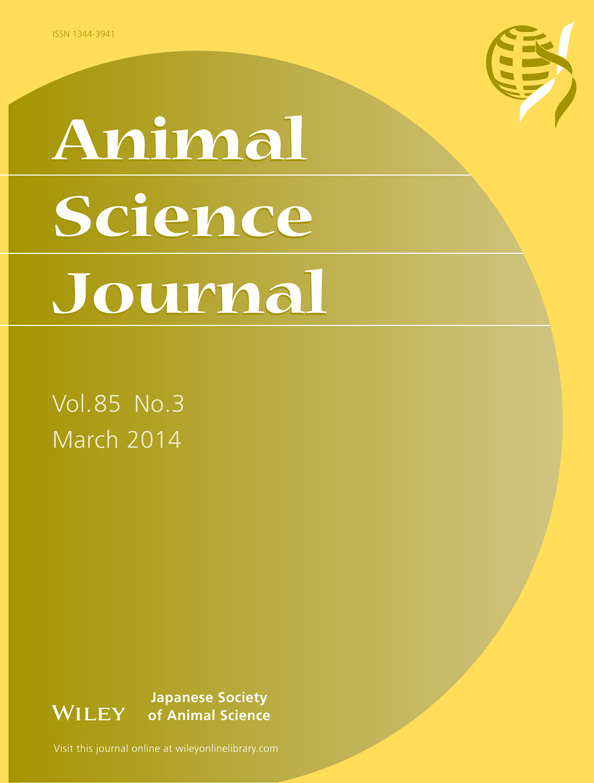How do visual and auditory cues influence calf stress reactions at weaning?
Abstract
We investigated the effects of visual and auditory information related to cow and calf stress responses at weaning. Three weaning conditions were established with physical separation only (PS), physical and visual separation (VS), and physical, visual and auditory separation (VAS). Stress responses such as vocalization and self-grooming, and changes of three maintenance behaviors (lying, walking and grazing) were recorded for experimental cows and calves in the respective conditions. Comparison of the data revealed that the cow responses differed slightly among groups. However, the peak frequency of vocalization was higher in the PS calves than in those of either VS or VAS. Self-grooming frequency was significantly different in calves and was high in the order of VAS, VS and PS calves. Furthermore, the percentage of time spent lying down was greater, and that of walking was less, in VAS calves than in either VS or PS calves. These results demonstrate that different information at weaning might strongly affect the stress responses of calves but not those of cows. Relative impacts of different types sensory information on stressors must be considered to plan animal-friendly weaning.
Introduction
Weaning is an unavoidable event in mammal development. In farm animals such as swine and cattle, for reasons of production efficiency, weaning tends to occur earlier than in the natural growing stage of young animals (Suzuki & Sato 1980; Krohn 2001; Sumner et al. 2008). With conventional practices, termination of milk feeding occurs nearly simultaneously with physical separation of mother–young pairs and a change of living environment. These drastic changes engender stagnation of the growth rate (Fraser & Broom 1998) and temporarily increase susceptibility to disease and digestive upset in young animals (Weary & Chua 2000; Jasper et al. 2008). Furthermore, these changes in environment engender behavior disturbances, such as loss of sleep, high distress calls, and increased general activity in cows and calves (Fraser & Broom 1998; Phillips 2002). Consequently, weaning is regarded as an extremely stressful event in a farm animal's life.
To mitigate the problems of weaning stress described above, various studies have been conducted to date. Haley et al. (2005) and Loberg et al. (2008) reported the problem of the simultaneous impact of stressful events such as the change of feeding procedure and the separation of a mother from her young, and reported the benefits of conducting them separately. Jasper et al. (2008) reported that a moderate change of feeding procedures fostered less stressful weaning. These methods ameliorated weaning stress. However, contradictory conclusions have been reported in light of the effect of information at weaning: Price et al. (2003) reported that fence-line weaning, which did not restrict visual and auditory stimulation at weaning, reduced behavioral stress responses and weight loss. However, Stĕhulová et al. (2008) and Enríquez et al. (2010) found no effect on the responses of cows and calves under similar visual and auditory contact conditions at weaning. Consequently, it is necessary to clarify not only the weaning technique but also the factors affecting their stress responses at weaning to develop more effective methods of animal-friendly weaning.
For this study, we established three weaning conditions and investigated how information of different types, such as visual and auditory, influences the stress responses of cows and calves at weaning.
Materials and Methods
Nine Japanese black (Bos taurus) cow–calf pairs were examined as experimental subjects in this study. They were kept at the Field Science Center, College of Agriculture, Ibaraki University, Japan. They included a primiparous and eight multiparous cows (mean parity was 2.8 ± 1.5) and their calves. The cows were fed 10 kg of corn silage and 2 kg of concentrates two times per day per cow, and ryegrass hay was fed ad libitum. The calves were born in the same year. They spent a week in a parturition pen with their dams. Subsequently, they were moved to a neighboring paddock and were nursed until the weaning period. Although the calves were able to consume calves’ specialized forage such as calf starter and timothy hay at a creep feeding system, they also received nourishment from their dams by suckling slightly. They always contacted their dams.
The study was implemented about 4 months after the cows gave birth. The calves’ mean age was 125 ± 10.1 days. Their mean body weight was 144 ± 16.2 kg. At weaning, we divided the cow–calf pairs into three weaning groups. (i) Physically separated pairs (PS) were calves weaned from their dams to the paddock which was 10 m distant from their dam's paddock. Therefore, the cow–calf pairs had visual and auditory contact, but no physical contact. (ii) Visually separated pairs (VS) were those for which calves had been weaned from their dams to the paddock, which was 10 m behind their dams’ paddock and separated by the cow shed. Therefore, the cow–calf pairs had only auditory (vocal) contact. (iii) Visually and auditory separated pairs (VAS) were those for which calves were weaned from their dams to a paddock that was 500 m distant from the dams’ paddock. Therefore the cow–calf pairs had neither visual nor auditory contact. During this study, the weaned calves were fed 3 kg corn silage and 2 kg concentrates twice a day per calf. Timothy hay was fed ad libitum. In contrast, the cows were kept in the same conditions as those before weaning.
Observations were conducted a day before weaning and 1, 2, 3, 5 and 7 days after weaning. They were started after morning feeding. Details of the time schedule of these observation days are shown in Figure 1. We recorded the frequencies of vocalization and self-grooming of the cow–calf pair (VAS was calves only) by continuous sampling. In addition, to determine the effect of the weaning treatment, three maintenance behaviors of lying down, walking, and grazing (including roughage intake) were recorded, respectively, using a 2-min (before weaning) or 1-min (after weaning) scan sampling method.

Diagram of the observation schedule. Black cells show observation times of subjects.
Statistical analysis
Frequencies of vocalization and self-grooming of the cow–calf pair were summarized for each animal for each observation time. The time budget of each maintenance behavior was summarized for each animal for each day. The data obtained before weaning were summarized for each animal for a day.
Data, except for those collected before weaning, were analyzed as repeated measures mixed models (REML). The cows and calves were treated as a random effect of this model and nested within the weaning groups. The weaning group, the observation time and their interaction were analyzed as fixed effects. The assumptions of a parametric method (normality of error, homogeneity of variance and linearity) were confirmed from a plot of coefficients versus fitted values, and suitable transformations were applied where required. Post hoc Fisher's protected least significant difference (LSD) tests were used to describe the relation further in cases where significant results were observed between weaning groups. The frequencies of vocalization and self-grooming during the peak observation time in the different weaning groups were also compared using Fisher's protected LSD test.
Results
The frequency of vocalization in each weaning group is shown in Figure 2. No difference was found in the vocalization of the calves among weaning groups (VS: 53.1 ± 33.2 calls/30 min, PS: 119.9 ± 99.8 calls/30 min, VAS: 40.7 ± 39.5 calls/30 min, F2,6 = 2.9, not significant (NS)), although those in each observation time were significantly different (F17,102 = 13.4, P < 0.0001) and their interaction was significant (F34,102 = 2.8, P < 0.0001). The peak time of vocalization was confirmed from the first day to the second day from separation. Those of PS calves (11 h: 316.3 ± 103.2 calls/30 min) tended to be higher than those of VS (25 h: 137.3 ± 67.4 calls/30 min, P = 0.062) or VAS calves (25 h: 136.7 ± 110.6 calls/30 min, P = 0.061). The vocalization frequencies of the cows were also significantly different among observation times (F17,68 = 11.5, P < 0.0001). However, no difference was observed among weaning groups (VS: 26.6 ± 34.6 calls/30 min, PS: 22.9 ± 32.9 calls/30 min, F1,4 = 0.01, NS), their interaction (F17,68 = 0.55, NS),or the peak frequencies (PS: 10 ± 16.4 calls/30 min, VS: 97 ± 7 calls/30 min; both 25 h, NS).

Mean frequencies of vocalization in each group (± SD). Upper: calves, lower: cows. Each symbol signifies a group.
The frequencies of self-grooming of calves were significantly different among weaning groups (VS: 4.9 ± 3.5 times/30 min, PS: 2.6 ± 3.8 times/30 min, VAS: 8.0 ± 5.0 times/30 min, F2,6 = 9.34, P < 0.05, Fig. 3). Post hoc tests revealed that the self-grooming frequency of VAS calves was higher than that of VS (P < 0.05) or PS calves (P < 0.0001). Furthermore, the self-grooming frequency of VS calves was higher than that of PS calves (P < 0.005). However, those in peak times were not concentrated, like vocalization, and were not significantly different among the weaning groups (VS: 97h: 14.7 ± 12.2 times/30 min, PS: 147h: 12.3 ± 9.3 times/30 min, VAS: 49h: 17.3 ± 20.2 times/30 min). The frequency of self-grooming was also significantly different among observation times (F17,102 = 4.48, P < 0.001). However, no interaction was found. The frequencies of self-grooming of the cows were also significantly different among observation times (F17,68 = 2.2, P < 0.05). However, no difference was found among weaning groups or their interaction.

Mean frequencies of self-grooming in each group (± SD). Upper: calves, lower: cows. Each symbol signifies a group.
The time budget of the three maintenance behaviors after separation is presented in Figure 4. These behaviors of the calves were significantly different among weaning groups (lying down – F2,6 = 7.6, P < 0.05; walking – F2,6 = 12.8, P < 0.01; and grazing – F2,6 = 6.3, P < 0.05). Furthermore, that of lying down of VAS calves (39 ± 19% of observation) was significantly higher in PS (26 ± 16%, P < 0.05) and VS calves (17 ± 11%, P < 0.005). The walking of VAS calves (9.3 ± 8.6%) was lower than that of PS (33 ± 20%, P < 0.0001) or VS calves (26 ± 13%, P < 0.0001). In addition, the grazing of VS calves was greater than that of PS calves (P < 0.05). Significant differences were also found in observation times for the percentages of time spent lying down (F4,24 = 13.4, P < 0.001) and walking (F4,24 = 18.1, P < 0.0001) in calves. No differences were found in the percentages of lying down or grazing of cows. However, the walking was significantly different among weaning groups (F1,4 = 11.4, P < 0.05) and observation times in cows (F4,16 = 6.5, P < 0.005).

Percentages of maintenance behavior in each group (± SD). (a–c) are calf behaviors: (a) lying down, (b) walking, (c) grazing; (d–f) are cow behaviors: (d) lying down, (e) walking, (e) grazing. Each symbol signifies a group.
Discussion
Increased vocalization is generally used as an indicator of the stress response at weaning. Many reports have described that a great increase is observed between 9 h and 24 h (Weary & Chua 2000; Flower & Weary 2001). A great increase was also observed in our study between the first and second day after separation of cows and calves. Furthermore, the frequencies of calves’ vocalizations in the peak observation time tended to be different among the weaning groups. In particular, those of PS calves were 2–3 times higher in comparison to those of VAS and VS calves. Therefore, the calves in the PS condition might be more stressed than calves of either of the other two groups and the frequency of vocalization at weaning might be influenced by visual information. Although Price et al. (2003) reported a positive effect of a weaning procedure resembling that of PS, in which cows and calves were able to watch and mutually call during separation, their cows were housed in a pasture adjacent to their calves. They were able to have physical contact with their calves even after separation in their system. A study by Stĕhulová et al. (2008) and our study described above, for which the distances between cows and calves were somewhat greater (about 8–10 m), showed no such effect. These results suggest that visual and auditory contact situations at weaning might not show benefits unless conducted in an extremely well designed condition allowing contact. Unsuitable conditions might engender an adverse effect. Furthermore, no significant difference in calves’ vocalizations was detected among the weaning groups. In this study, the experimental animals in each group were few. Furthermore, large variations were observed in some of the data. Studies involving more animals might be necessary to clarify clear differences among treatments.
A significant difference among weaning groups exists for the self-grooming of calves, although no clear peaks were observed. The less the weaning groups received cow information, the more self-grooming was performed. Self-grooming is regarded as a conflict behavior of animals. It is observed under circumstances of frustration (Kerr & Wood-Gush 1987; Sato & Kuroda 1993). Therefore, this result might imply that the lack of sensory cue of the cow at weaning increased the calves’ frustration and anxiousness. Although this interpretation is nearly the opposite of the result of vocalization, it can be well understood in combination with the result of the maintenance behaviors. For example, in VAS calves, which showed a high frequency of self-grooming, the percentage of lying down was also higher than that of calves in either of the other two groups. The PS and VS calves showed a significantly higher percentage of walking than did VAS calves. These results suggest that the calves in PS and VS moved around the paddock and that the calves in VAS were lying down quite a lot after weaning. Generally, to perform self-grooming, a motionless situation is necessary. Furthermore, it is well known that the most definitive weaning responses of calves are increases in their activities (Weary & Chua 2000; Flower & Weary 2001; Price et al. 2003). Consequently, although the frequency of self-grooming of these calves would reflect their frustrated state at weaning, these activities would be strongly influenced by differences of maintenance behaviors.
Responses in the cows also seemed to reflect distress at weaning. However, different from the report of a study by Stĕhulová et al. (2008), the behaviors in these two groups differed only slightly. Because of the research conditions, that study was conducted only in PS and VS conditions in cows. Although it is necessary to investigate the influence of the weaning condition on cows including the effect of auditory information by the VAS condition, results reported here might indicate that blocking visual information influences the stress response only slightly in cows at weaning. In addition, the reaction of cows at weaning was influenced mainly by discomfort of their udder condition because of the lack of suckling (Flower & Weary 2001). Therefore, their milk-producing ability and stage of lactation might rather influence the stress response of cows at weaning.
For this study, we established three different visual and auditory conditions to clarify the effect of the stress responses in cow–calf pairs at weaning. Results show that differences in information at weaning might strongly affect the stress responses of calves, but not of cows. In particular, being able to see the cow affected expression of various stress responses, such as vocalization and activity, in calves. Therefore, it would be necessary to control visual information for the reduction of calf stress levels at weaning. Even though auditory information from cows would also affected the increase of activity associated with weaning stress in calves, it was suggested that the impact might be smaller than visual information. Furthermore, these results would be insufficient to compare the stress level of these weaning conditions and it would be necessary to supplement the present findings with physiological data.
These results suggest that different information at weaning might strongly affect the stress responses of calves and the impact of information on the stressor must be considered when developing a more effective method of animal-friendly weaning.




